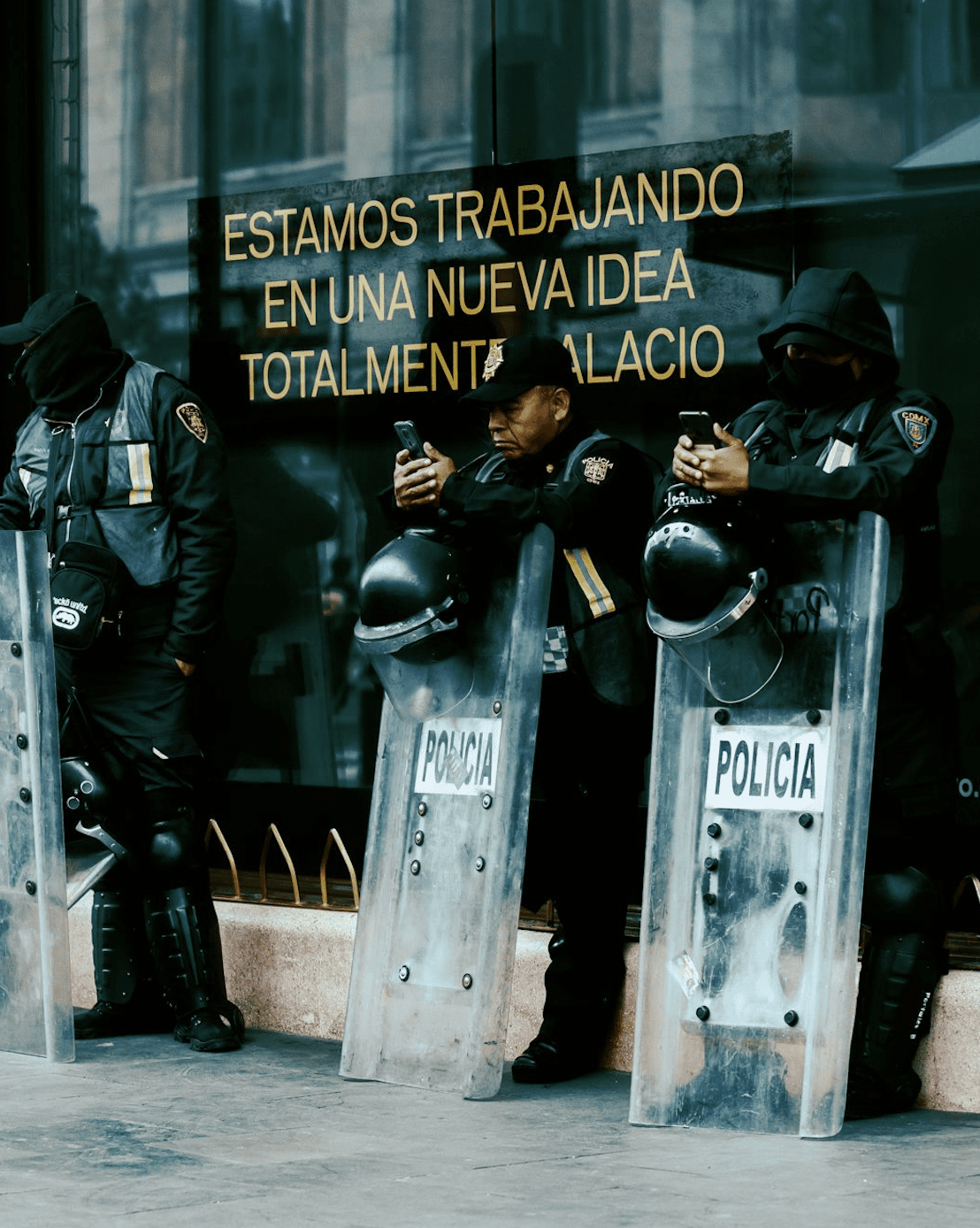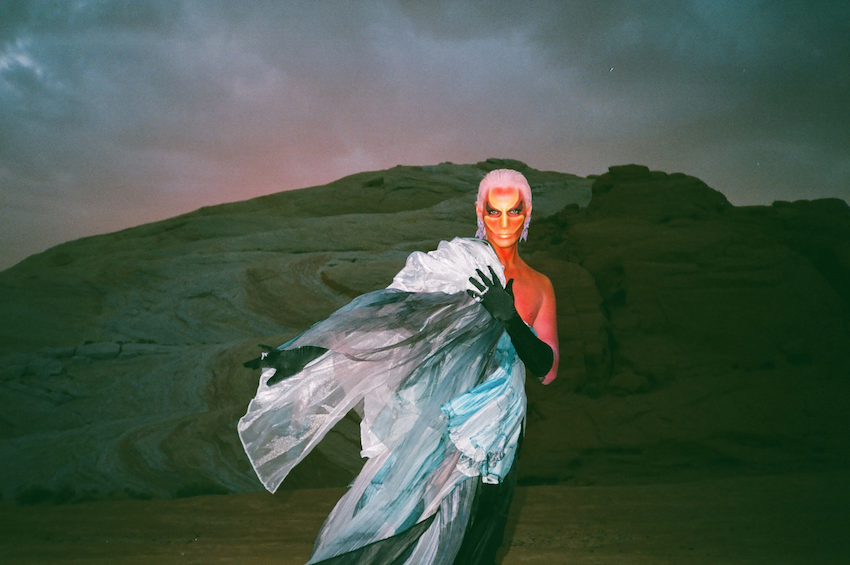Sitting by myself at Mama Rumba in Mexico City, I sipped on a mezcal margarita and waited for my guests to arrive. The club was adorned with tropical flowers and neon signs that read “salsa” and “baila,” and the waiters—dressed in white button-down shirts and ironed pants—diligently attended to their customers. Music played from the speakers while the musicians began warming up. The Caribbean-inspired club in the middle of Mexico’s capital was the perfect symbol of just how fluid Latin American culture can be: mainland and island rhythms, Mexican mezcal and Puerto Rican plantains, all flowing through bodies and taste buds of so many of the people sitting here, like me, looking forward to a dance. In this moment, I was not one thing or another, but a mix of many: an American in a foreign place, the daughter of a Mexican immigrant returning to her father’s homeland, a woman sitting alone at a bar, scribbling into a notebook.
 Photograph by Dave Krugman
Photograph by Dave Krugman
Before I finished my first drink, a curly-haired man with beaming energy, wearing a short-sleeved button-down decorated with palm trees shouted, “Vinny!” over the clinking of shot glasses and the tuning of instruments. Carlos Marcial pulled me in for a hug, patting my back like an uncle I had not seen in a long time. The renowned crypto artist then introduced me to his wife and collaborator, Alondra Durán, who wore a beautiful, flowy dress, perfect for spins and turns. Under a neon sign that read “Havana,” we ordered a round of mezcal and waited for the music to begin.
“So, this is your first time in Mexico City,” Carlos asked me. I nodded, adding that I had only been to Monterrey to visit my father’s family. I’ve always felt at home in Mexico, even though it is not where I grew up, and Spanish is not my maternal language. “I feel so honored to have been born here [in Mexico City]” Carlos told me, “just because…even though I wasn’t raised here, I had to come back because I was born here and I needed to see, you know, why I was born here, why it was a part of my narrative.” Carlos spent most of his childhood in Puerto Rico, which you can tell right away from his bombastic demeanor, the way he pronounces his r’s and s’s in Spanish, and the way he switches seamlessly from Spanish to English and back again, just like the Puerto Ricans I had grown up around in the Lower East Side in New York City.
 Photograph by Nain Leon
Photograph by Nain Leon
We got to talking about NFTs right away, partly because we’re both obsessed with the technology, but also because I had bought my first NFT just a few weeks before my trip. It was the first time in my life that I owned something other than a store-bought item or a debt. “The first NFT I ever sold, I sold it for like $100,” he told me. “And at the time I was like ‘holy shit! $100!’ I had no idea where this was going, but the fact that I had earned money from my art, which I would be making anyway, was really amazing.”
In a matter of a few years, Carlos went from lackluster design jobs to being a top-selling crypto artist who teaches university students about blockchain technology. As Carlos began selling more artworks, he also began collecting, a phenomenon in the crypto art world which, to me, articulates both a camaraderie between artists and a relatively new level of wealth among them. On SuperRare, artists retain 85% of the money from their initial sale, and collect royalties on the secondary market in perpetuity, which generates a continuous income stream that grows with the artist’s reputation. And because crypto artists don’t need to rely on auction houses and galleries—many of which are impossible to get into if you don’t have the right education, status, or address—they can finally be in control of their artistic visions, as well as their sales. Making art is beginning to offer a mass of people stability, money, and freedom, with no strings attached.
“It’s an underground movement,” Carlos said in between dances. “It doesn’t matter if the traditional art world, if Hollywood, whatever the cultural niche, sees value in what you’re doing.” Because in crypto, there is a market for everything: fine art, memes, animation, you name it. “How crazy is it that you can have artists in the middle of nowhere,” he added, “and they still have a chance of tapping into a global art market? And then you add artists from Mexico and Thailand and Russia, and you stop and think, ‘What happened here? How did this happen in such a short amount of time?’”
I think people get stuck in the money, stuck in the speculation, the influencers, the hype cycle, and that’s entertainment, but there’s something about believing in an asset when no one else believes in it, just because you connect with the artist and want them to succeed.
— Carlos Marcial
|
|
Kevin McCoy’s digital artwork “Quantum” (2014), regarded by many as the first NFT, sold in the NFT boom of 2021 for upwards of a million dollars. Minted on the Namecoin blockchain, the smart contract was intended to remedy the way digital artworks circulated online—which usually resulted in artists losing credit for their creations—and as a way for artists to sell their work directly to their fans.
NFTs have knocked down barriers, allowing more people to make, buy, and sell art, regardless of who they are, what school they went to (if any), and where they are located in the world. And while this sounds great to any art-maker, including poets and visual artists who may have otherwise made peace with the idea of never making money from their work, it holds even more weight for people who live in countries where political corruption, social unrest, and economies built on systemic oppression are the norm. In Mexico, as in much of Latin America, an artistic, political, and financial revolution has long been overdue.
Art and Revolution
The early economy of Mexico was built on haciendas, or plantations, which dominated the rural countryside and employed millions of people in an oppressive financial structure not unlike that featured in Steinbeck’s American classic “The Grapes of Wrath.” Up until the 19th century, it was not uncommon for people to be paid in commodities from stores owned by the same people who employed them. Prices fluctuated, never in the consumer’s best interest, and many workers were caught in a cycle of never-ending debt, a cycle that, in many parts of the country, persists today.
In 1907, half of the people living in Mexico had never seen a peso in their lives.
In 1910, Mexican artists like José Clemente Orozco, David Alfaro Siqueiros, and Diego Rivera began crafting murals on government buildings and in the streets. They depicted scenes from the revolution: soldiers in white, politicians in black, farmers in the fields of haciendas under the burning sun, women making tortillas and grinding moles with babies tied to their backs; the poor masses rising up against the status quo. Art was made accessible to the people, not hidden away, and it featured their lives, their struggles, their dark skin and jet black hair.
When you see the migrants here in Mexico going to the United States, they’re looking for jobs. Here in Mexico, if you fail, you fall all the way. There’s no bottom.
— Carlos Marcial
 Mural by Diego Rivera
Mural by Diego Rivera
Revolution or Renaissance
The NFT movement today has been compared to the Italian Renaissance on one hand, and to the Beanie Baby Boom on the other. The biggest obstacle for many people, including those who’d benefit most, has been their lack of access to understanding the technology. Those of us who grew up on the internet can see the value of NFTs, DAOs, and digital assets more readily, because we’re more accustomed to the tech that was the precursor to those inventions. We saw the programs being built, the value users placed in them, and felt connected to early internet art and communities. Then, we saw how Silicon Valley profited off of unpaid or under-paid labor. The difference with Web3 and NFTs is the people make the money, not the corporations.
“I think this is going to be like the Renaissance,” Carlos said. “But, you know, the Renaissance wasn’t decentralized. The artist was bound to whoever—the patron—and there was a whole stream of money, un montón de dinero, but the artists were still bound geographically, and working inside the castle.” The artworks, which were commissioned, tended to be portraits of nobles and still lifes, not artworks that came from their own hearts and minds. But collecting NFTs is an investment too, and one with huge headlines to boot. “I think people get stuck in the money, stuck in the speculation, the influencers, the hype cycle, and that’s entertainment,” Carlos told me when I asked about the crazy sales in 2021. Then he added, “but there’s something about believing in an asset when no one else believes in it, just because you connect with the artist and want them to succeed.” Which is exactly why people who bought works by XCOPY and Hackatao and Coldie at $25 in 2018 are now reaping the benefits of multi-million dollar sales on NFT Markets like SuperRare.
In the two years since the COVID-19 pandemic, NFTs have gone viral, and artists, like Carlos, have quit their day jobs and realized their dreams. Part of that is because so much of our attention was diverted from the physical world into the virtual. But Carlos is also certain that another reason is as a reaction, and a remedy, to corruption. “At the same time, [blockchain] is making transparent three of the most opaque human industries: governance, finance, and the art market. In Mexico, in the third world, governments don’t like transparency. And in the traditional art world you have pseudonymous bidders, and where the money goes and what happens on the secondary markets, no one knows. So what is the true value?” Is it whatever the auction house tells you?
For me it has been about, how do I bring the culture that I grew up around in Puerto Rico, and in Mexico, how do I bring that to crypto, to the metaverse, how do I make it last forever?
— Carlos Marcial
 Photograph by Dave Krugman
Photograph by Dave Krugman
 Photograph by Dave Krugman
Photograph by Dave Krugman
With a globally distributed ledger that is accessible to anyone with an internet connection, blockchain technology has truly revolutionized all aspects of the financial world. It has made it possible for people to see the provenance of any artwork, token, or contract, as well as to track every on-chain transaction ever made. This readily available data is intrinsically inspirational as it calls to mind a form of ingenuity that many Gen-Xers, Millennials, and Zoomers have only seen in text books and movies.
For the first time since the Boomers were young, a gold rush-like opportunity has emerged, with many assets still affordable to adventurous young people willing to take the risk. You can buy into cryptocoins with prices under $100, and even buy fractions of successful ones like Bitcoin and Ethereum. You can buy NFTs for as little as $1 on platforms like Teia. And all of these things have the potential to eventually turn a profit. In fact, you can become a millionaire off of shit coins or flipping funny PFP cartoon characters, if you happen to buy in–and sell–at the right time. Which is not to say that the rich aren’t making fortunes off of crypto, too, but to the tens of millions of people that never thought they could pay off their student loans, let alone buy a home, NFTs and crypto coins are a ray of hope. “The gateway asset,” Carlos said, “kind of like the gateway drug into assets, for our generation, it’s crypto.”
Now apply that newfound hope to places where there is no path to higher education (not even through debt), where there are capital controls and devastating crashes every decade, where every level of society is tainted by corruption, and where being poor is as good as a death sentence. For millions of lower and middle-class Mexicans, including most of my family in Monterrey, neither financial security nor faith in the system is forthcoming. “When you see the migrants here in Mexico going to the United States, they’re looking for jobs,” Carlos said. “Here in Mexico, if you fail, you fall all the way. There’s no bottom.” Which is exactly why my father left in 1964 and stayed in America long after his student visa expired. A culture existing under this kind of oppression has never had the opportunity to pull itself up. “That’s the beauty of crypto,” Carlos said, “and I think that’s why it has become ever so popular, especially in a place like Mexico City, where you have a young population of well-educated people. Bitcoin, and crypto more generally, has been their first interaction with things of value.”
 “Magritte’s Weed Pipe” (2019) by Carlos Marcial on SuperRare
“Magritte’s Weed Pipe” (2019) by Carlos Marcial on SuperRare
Thanks to crypto, you don’t need access to insane amounts of wealth in order to collect art. You can choose to participate—and build your wealth—in the crypto economy, one less dependent on connections and bribes. You can rise to fame and fortune without appeasing traditional power structures. Another path has opened—not a panacea, but a gateway, if you will—to taking control of your narrative, to giving yourself options, to earning power through culture.
“Before NFTs, I think a lot of Mexican contemporary artists and Puerto Rican artists felt like, ‘I need to fit into the mold of whatever is popular, wherever the art market centers are in the world,’” Carlos said. “And that’s what SuperRare and crypto art has been building, precisely that you can bring all of that other part, you can bring that with you or you can stay in it and still be an artist that can live off their cultural production.”
Carlos’s art is emblematic of this newfound tradition. It’s colorful and dynamic in places, dark and mysterious in others. There are ancient symbols and animals that any person of Latin American descent would quickly recognize as their own: a jaguar, coyote, and serpent-god, each decorated in a unique pattern and brought to life by digital technology. But then he also plays with the masters of history, paying homage to Magritte and Duchamp while bringing them up to date.
 “I will not drown because I have learned to fly” (2020) by Carlos Marcial on SuperRare
“I will not drown because I have learned to fly” (2020) by Carlos Marcial on SuperRare
 “Coyote’s Soul” (2020) by Carlos Marcial on Nifty Gateway
“Coyote’s Soul” (2020) by Carlos Marcial on Nifty Gateway
The cultural capital Carlos brings to the art world goes beyond just celebrating Latin American culture. “For me it has been about, how do I bring the culture that I grew up around in Puerto Rico, and in Mexico, how do I bring that to crypto, to the metaverse, how do I make it last forever?”
“What colonization does is it puts layers upon layers on top of what was already there,” he added, “and if you are a creator, and you can still create in the midst of all of this crazy, colorful syncretism, then I think very special things will come out of it.” Carlos’s creations embody a santeria that only the mixing of cultures and the preservation of ancestry can produce: “a virgin, the indigenous artifacts, and the Coke bottle all a part of the same altar,” he observed, showing how everything, the good and the bad, can be intertwined, and transformed into something magical.
 GIF by Nathan Beer
GIF by Nathan Beer
Into Our Crypto Future
Carlos Marcial and his wife Alondra—a Mexican-born artist, feminist, and academic of indigenous decent—have recently launched one of SuperRare’s first five Spaces. Metafísica will onboard new artists from all over Latin America, and is focusing on female voices for their launch. At a small dinner party at their home, Alondra told me how excited she was to bring crypto to the people, especially to women and people of indigenous descent. Thanks to Carlos and Alondra, historically oppressed people who have rarely had the chance to succeed will get their shot on SuperRare. “[SuperRare Spaces are] an experiment, you know, and breaking it apart in a DAO and giving different people a chance, it’s too good to be true and too good not to try it out to see if it’s the future of how companies can organize,” Carlos ruminated. “It’s clear to me that whatever we’ve had before, it’s not working. So, why not?”
 Photograph by Nain Leon
Photograph by Nain Leon
It’s been a slow lead up to the invention of Bitcoin, but at the very least, we can see something good coming out of it all, like avant-garde literature and art after World War I and the Influenza pandemic of 1917 or the abstract expressionism and conceptual art that came out of the decades following World War II. “[Crypto art] is like post-war art, or turn of the century art,” Carlos noted. “We have so many crazy, historical things happening, and I think that you won’t be able to talk, in 20 years, about COVID without talking about NFTs and crypto art.” Sure, these years were and continue to be difficult—houses are expensive, the stock market is headed toward a recession, and new coronavirus variants seem to pop up every month—but transitions from the old world to the new almost always are. So what is Carlos’s advice?
“I’m gonna buy more Bitcoin, fuck it.”






